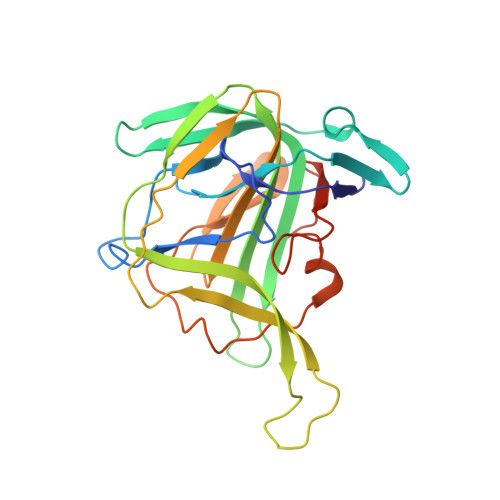Structure and immunogenicity of the murine astrovirus capsid spike.
Lanning, S., Pedicino, N., Haley, D.J., Hernandez, S., Cortez, V., DuBois, R.M.(2023) J Gen Virol 104
- PubMed: 37910165
- DOI: https://doi.org/10.1099/jgv.0.001913
- Primary Citation of Related Structures:
8TN8 - PubMed Abstract:
Human astroviruses (HAstVs) are small, non-enveloped icosahedral RNA viruses that are a significant cause of diarrhoea in young children. Despite their worldwide prevalence, HAstV pathogenesis studies and vaccine development remain challenging due to the lack of an animal model for HAstV infection. The recent development of a murine astrovirus (MuAstV) infection model in mice provides the opportunity to test proof-of-concept vaccines based on MuAstV antigens. To help establish a system in which an astrovirus capsid spike-based vaccine could be tested in vivo , we designed and produced a recombinant MuAstV capsid spike protein based on predicted secondary structure homology to HAstV spike proteins. The recombinant MuAstV spike can be expressed with high efficiency in Escherichia coli and retains antigenicity to polyclonal antibodies elicited by MuAstV infection. We determined the crystal structure of the MuAstV spike to 1.75 Å and assessed its structural conservation with HAstV capsid spike. Despite low sequence identity between the MuAstV and HAstV spikes and differences in their overall shapes, they share related structural folds. Additionally, we found that vaccination with MuAstV spike induced anti-MuAstV-spike antibodies, highlighting that the recombinant spike is immunogenic. These studies lay a foundation for future in vivo MuAstV challenge studies to test whether MuAstV spike can be the basis of an effective vaccine.
Organizational Affiliation:
Department of Molecular Cell and Developmental Biology, University of California Santa Cruz, Santa Cruz, CA, USA.















